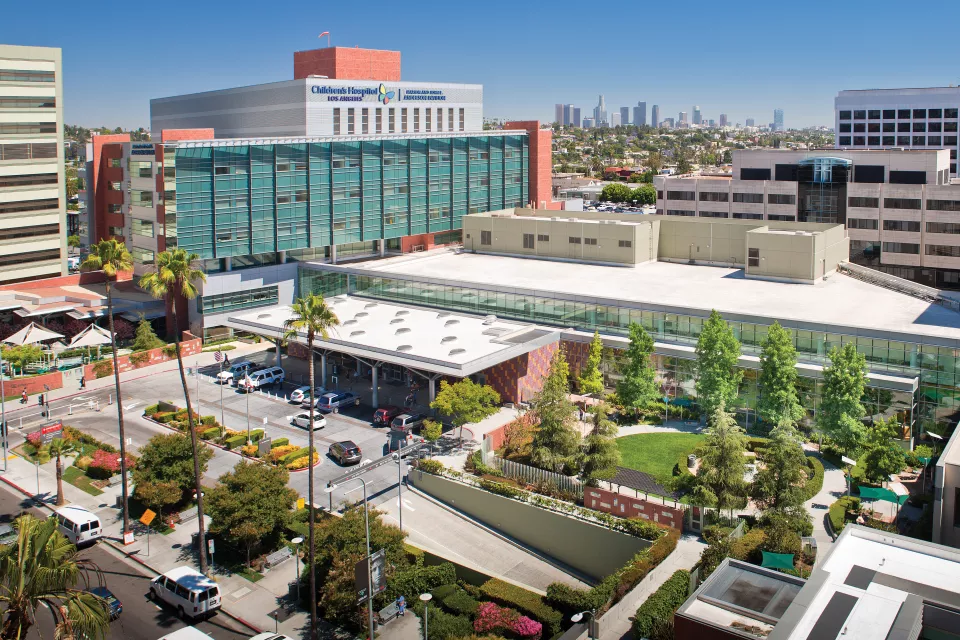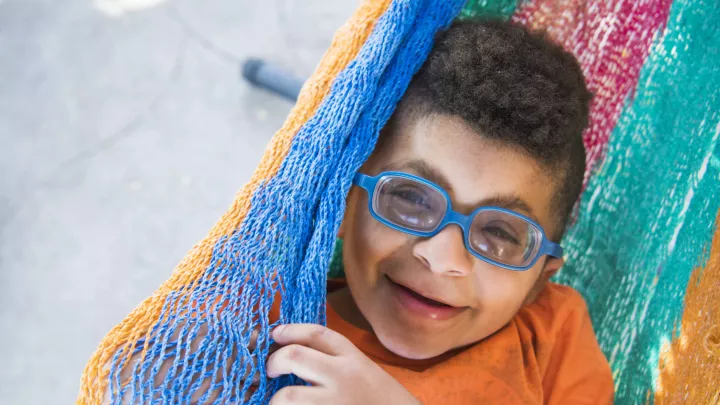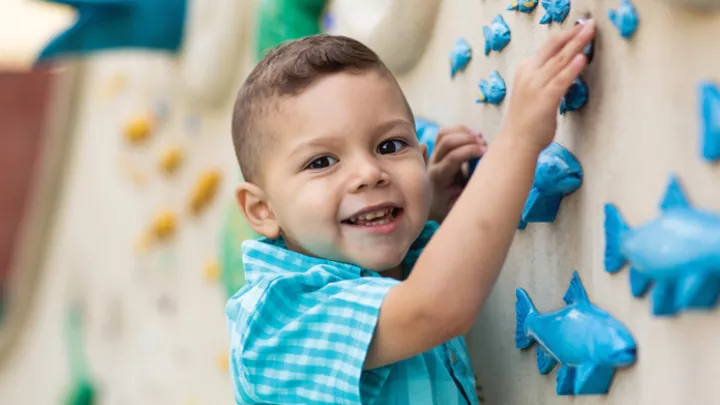The Division of Otolaryngology - Head and Neck Surgery treats an estimated 13,000 patients annually — from newborns to young adults. We are the largest group of pediatric fellowship-trained Ear, Nose and Throat (ENT) specialists in the Los Angeles area.
Our physicians also serve as full time faculty members of the Keck School of Medicine of the University of Southern California, and our physicians bring the most up-to-date evidence-based practices and treatment options to our patients and their families.
Commonly Treated Conditions
- Airway disorder
- Chronic sinusitis
- Congenital head & neck tumors
- Ear infections
- Hearing loss
- Hoarseness
- Neurotology diseases
- Obstructive sleep apnea
- Sleep apnea
- Vascular lesions
Services and Procedures
- Adenoidectomy
- Bronchoesophagology
- Bone anchored hearing aids (BAHA)
- Congenital aural atresia repair
- Craniofacial otolaryngology
- Ear drum repair
- Ear drum reconstruction
- External ear reconstruction
- Facial nerve disorder treatment
- Fiberoptic laryngoscopy
- Foreign body removal
- Laryngea reconstruction
- Laser laryngoscopy
- Laser bronchoscopy
- Mastoid disorder treatment
- Middle ear reconstruction
- Myringotomy with ventilating tubes
- Nasal endoscopy
- Otology treatment
- Pediatric sinus disease treatment
- Septoplasty
- Skull base surgery
- Speech and voice evaluation
- Tonsillectomy
- Trachea reconstruction
- Tumor removal from the cerebellopontine angle
- Tumor removal
- Voice disorders
Research Activities
The Division of Otolaryngology – Head and Neck Surgery is committed to developing clinical and technological advances in our field. Our surgeons create and participate in unique and innovative research studies which may directly impact or have the potential to impact our patients and their families with the ultimate goal of improving outcomes. As we strive to answer clinical and basic science questions, you and your child may have the opportunity to participate. Below are summaries of some currently active research projects and some completed projects. If you are interested in participating or simply learning more, feel free to ask your doctor at your next visit.
Retrospective Studies
Tongue tie and frenotomy/frenulectomy: investigating the impact of referral patterns and variation between providers on frenotomy/frenulectomy rates among children with tongue tie or ankyloglossia.
Flexible endoscopic evaluation of swallowing (FEES): reviewing our experience with children of all ages who have a FEES test to investigate factors that may impact participation and exam success rates.
Ear tubes in children with cleft palate: evaluating infants who have ear tubes placed at the same time as repair of the cleft lip.
Intensive care unit (ICU) admissions after surgery: assessing factors that may contribute to ICU admissions after tonsillectomy and endoscopic procedures.
Prospective Tissue Studies
Thyroglossal duct cysts and sinuses: excised thyroglossal duct specimens are evaluated to determine the effectiveness of a novel surgical approach to prevent recurrent or persistent disease.
Bacterial proteins in middle ear fluid: middle ear fluid removed at the time of ear tube placement is collected to learn more about the types and quantities of bacteria and/or viruses present to improve ear infection treatment options.
Tissue engineering: tracheal (windpipe) tissue-engineered airway grafts to be used for surgery in children with laryngotracheal stenosis or a narrowing of the windpipe.
Adenoid inflammation: the inflammatory reaction present in enlarged adenoids is studied and may lead to improved therapy for those with children with snoring and sleep disordered breathing/sleep apnea.
Technology
Technological advances of imaging or instrumentation, mobile applications, and home-based tools are exciting and emerging fields in medical care. Below are examples of how we study new technologies for potential use in clinical care.
Fitbit: evaluation to determine if a Fitbit device could be used to measure nighttime movements in children that may be indicative of breathing problems during sleep.
Cellscope: testing the use of an attachment that can turn a smart phone into an otoscope in order to monitor the status of an ear tube at home.
SenTec: collaboration with the department of anesthesia to evaluate the use of a device that measures the level of oxygen in the blood through the skin to better monitor children with sleep apnea who undergo surgery to remove their tonsils and/or adenoids.
Collaborations
Collaborations with healthcare companies and Divisions in and outside of CHLA
Aerodigestive Clinic: This multidisciplinary clinic is comprised of health care providers from gastroenterology, pulmonology, otolaryngology, and speech and language pathology and is designed to see and treat children with complex and overlapping medical issues. For those that choose to participate, we are currently enrolling children seen in this clinic in a prospective registry in order to identify more effective treatment options and improve outcomes.
Otonomy studies: We have collaborated with the pharmaceutical company Otonomy on the use of FDA-approved medications to treat ear infections and those patients with a draining ear.
Use of a drain after Thyroglossal duct cysts and sinuses removal: collaboration with our colleagues at Boston Children’s Hospital to evaluate the use drains and complication rates following thyroglossal duct cyst/sinus excision.
Publications
Below is a selected list of our division’s published works.
V. Angajala, K. Hur, L. Jacobson, C. Hochstim, Geographic health disparities in the Los Angeles pediatric neck abscess population, Int. J. Pediatr. Otorhinolaryngol. 113 (2018) 134–139. doi:10.1016/j.ijporl.2018.07.043.
N. Bhandari, D.M. Don, J.A. Koempel, The Incidence of Revision Adenoidectomy: A Comparison of four Surgical Techniques over a 10-year Period, Ear. Nose. Throat J. 97 (2018) E5–E9. doi:10.1177/014556131809700601.
J.A. Brooks, M.J. Cunningham, J.A. Koempel, K. Kawai, J.K. Huang, R.E. Weitzman, B. Osterbauer, A.L. Hughes, To drain or not to drain following a Sistrunk procedure: A dual institutional experience, Int. J. Pediatr. Otorhinolaryngol. 127 (2019) 109645. doi:10.1016/j.ijporl.2019.109645.
J.E. Dohar, D. Don, J. Koempel, C.H. Lu, D. Hakanson, K.H. Chan, Safety and efficacy of intratympanic ciprofloxacin otic suspension post-tubes in a real-world pediatric population, Am. J. Otolaryngol. 39 (2018) 101–106. doi:10.1016/j.amjoto.2017.12.016.
D. Don, D. Don, Fitbit Sleep Measures in Children with and without Sleep Disordered Breathing, Ann. Sleep Med. Ann. Sleep Med. (n.d.). http://scholarlypages.org/Articles/sleep-medicine/asm-1-001.php?jid=sleep-medicine (accessed September 18, 2018).
S. Farnoosh, D. Don, J. Koempel, A. Panossian, D. Anselmo, P. Stanley, Efficacy of doxycycline and sodium tetradecyl sulfate sclerotherapy in pediatric head and neck lymphatic malformations, Int. J. Pediatr. Otorhinolaryngol. 79 (2015) 883–887. doi:10.1016/j.ijporl.2015.03.024.
E. Garcia, B. Osterbauer, D. Parham, J. Koempel, The incidence of microscopic thyroglossal duct tissue superior to the hyoid bone, The Laryngoscope. 129 (2019) 1215–1217. doi:10.1002/lary.27291.
J. Huang, B. Osterbauer, J. Koempel, Prevalence of an intact hyoid bone at revision excision of a thyroglossal duct remnant, Int. J. Pediatr. Otorhinolaryngol. 113 (2018) 131–133. doi:10.1016/j.ijporl.2018.07.047.
K. Hur, V. Angajala, D. Maceri, C. Hochstim, Geographic health disparities in the Los Angeles pediatric esophageal foreign body population, Int. J. Pediatr. Otorhinolaryngol. 106 (2018) 85–90. doi:10.1016/j.ijporl.2018.01.010.
K. Hur, C. Liu, J.A. Koempel, Paranasal Rosai-Dorfman Disease with Osseous Destruction, Case Rep. Otolaryngol. 2017 (2017). doi:10.1155/2017/1453097.
Y. Luo, N. Shillingford, J.A. Koempel, Histopathologic Finding of Both Gastric and Respiratory Epithelia in a Lingual Foregut Cyst, Case Rep. Med. 2015 (2015). doi:10.1155/2015/278376.
E.A. Mair, A.H. Park, D. Don, J. Koempel, M. Bear, C. LeBel, Safety and Efficacy of Intratympanic Ciprofloxacin Otic Suspension in Children With Middle Ear Effusion Undergoing Tympanostomy Tube Placement: Two Randomized Clinical Trials, JAMA Otolaryngol. Neck Surg. 142 (2016) 444–451. doi:10.1001/jamaoto.2016.0001.
A. Martin, N. Tu, K. Duncan, M. Oberley, C. Hochstim, Primary pediatric lymphoma of the larynx: An unusual presentation of a rare histologic subtype, Int. J. Pediatr. Otorhinolaryngol. Extra. 19 (2018) 3–5. doi:10.1016/j.pedex.2017.10.001.
K. Mazhar, M. Gunawardana, P. Webster, C. Hochstim, J. Koempel, N. Kokot, U. Sinha, D. Rice, M. Baum, Bacterial Biofilms and Increased Bacterial Counts Are Associated with Airway Stenosis, Otolaryngol. Neck Surg. 150 (2014) 834–840. doi:10.1177/0194599814522765.
B. Osterbauer, J.A. Koempel, S.L.D. Ward, L.M. Fisher, D. M.Don, A Comparison Study of the Fitbit Activity Monitor and PSG For Assessing Sleep Patterns and Movement in Children, J. Otolaryngol. Adv. 1 (2016) 24. doi:10.14302/issn.2379-8572.joa-15-891.
A. Trecartin, S. Danopoulos, R. Spurrier, H. Knaneh-Monem, M. Hiatt, B. Driscoll, C. Hochstim, D. Al-Alam, T.C. Grikscheit, Establishing Proximal and Distal Regional Identities in Murine and Human Tissue-Engineered Lung and Trachea, Tissue Eng. Part C Methods. 22 (2016) 1049–1057. doi:10.1089/ten.tec.2016.0261.
C. Bertelsen, L. Jacobson, B. Osterbauer, C. Hochstim, Safety and efficacy of Early injection laryngoplasty in pediatric patients, The Laryngoscope. 129 (2019) 1699–1705. doi:10.1002/lary.27436.



